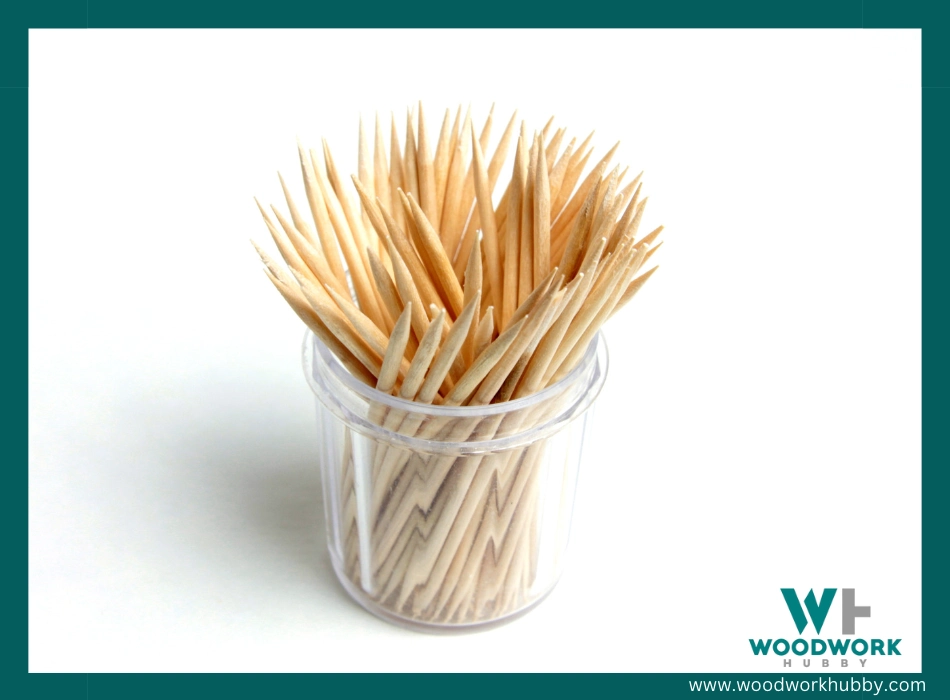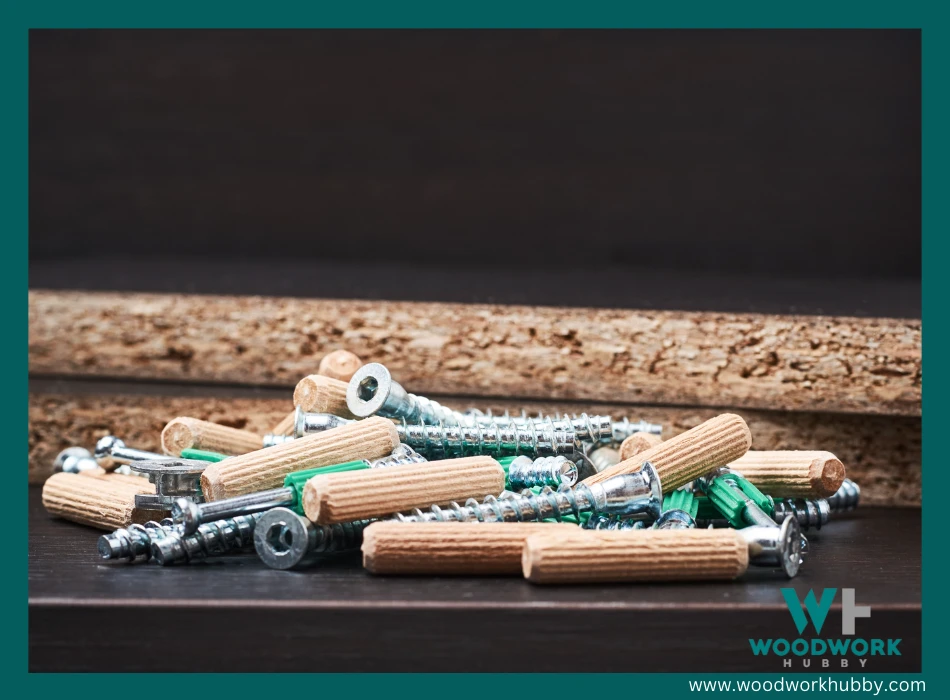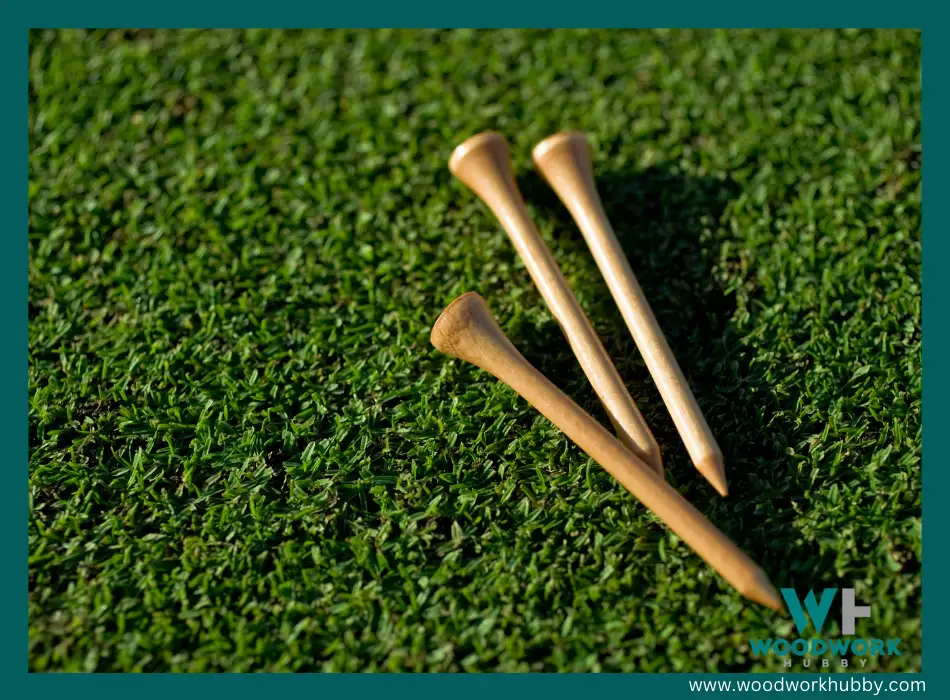Screw holes are often taken for granted. And I realized that yesterday when one of my shelves started sagging due to the screw holes getting loose. I have often resorted to the classic toothpick method to fix wide screw holes, but this time I saw an opportunity. I decided to test as many different solutions for tightening screw holes. And here’s what I found out.
To fix a screw hole, you can do one of three things. You can fill the hole with solid materials like matchsticks, toothpicks, or even dowels. The second option is a malleable material that hardens later (like wood putty or wood glue). And finally, you can increase the width of the screw itself.
I have had success with the following ways to fix wide screw holes:
- Fix a big screw hole with wood glue
- Use rawl plugs to fix the screw hole width
- Use toothpicks to fix the screw hole
- Make use of wooden dowels when fixing the screw hole size
- Fix the screw hole with wood putty
- Use steel wool to tighten the screw hole
- Fix an oversized screw hole with wooden plugs
- Use a golf tee to fill the screw hole
- Use larger screws to fix the screw hole
- Make a different screw hole
- Use Epoxy in the hole
- Use matchsticks to make the screw hole narrower
- Use wood chips and glue to improve the screw’s grip
- Add wood plugs and re-approach the screw hole
- Use a drill cavity plus to fix the screw to a larger hole
Fixing Big Screw Holes: A Brief Overview

While the section below covers the 15 ways in detail, I want to clarify how I made sense of these methods as variations of the three main ways to fix screw-hole width problems.
Upon executing different methods based on my intuition, online research, as well as woodworker buddies’ recommendations, I noticed that most methods were just variations of three things.
Solution 1: Fill The Hole With Solids
What do you do when a screw hole is too narrow? You remove wood. So the logical reversal of that is to add wood. Most woodworkers have learned that you don’t necessarily have to plug screw holes with wood.
Alternative materials also get the job done as long as they have a similar ability to hold screws.
Filling smaller holes with solids works better than larger ones. The broader the hole gets, the bigger the plus needs to be. Ultimately you have to graduate from matchsticks to dowels. And then from dowels to wood plugs.
Solution 2: Fill The Hole With Delayed Hardening Pastes/Gels
The second set of methods uses wood putty, wood filler, wood glue, etc., to fill the hole with a malleable material that eventually hardens. This leaves enough time for the screw to be driven into the screw hole before the material becomes rigid.
This solution works when the screw hole is just loose enough to become troublesome. If the screw threads have a tough time gripping the screw hole sides, it is time to use wood glue, resin, or putty to freeze the screw in place.
Solution 3: Make The Screw Bigger
You can switch the small screw with a bigger one to make it more compatible with the wider hole. But that’s not the only way to move the screw up in size.
You can also use rawls or anchors, as well as wrapping material, to make a screw thicker. The methods of fixing the hole in this category all offset the hole’s size difference by making the screw thicker.
Video showing one way to fix a screw hole
15 Ways To Fix A Screw Hole That Is Too Big
With the main solution categories covered, let’s look at individual ways to fix screw holes that are too big for their respective screws. Here are the methods I have used to fix my cabinet’s oversized screw holes.
1. Fix A Big Screw Hole With Wood Glue
Novice woodworkers might underestimate the grip strength of wood glue. Intermediates and advanced woodworkers know that wood glue can hold screws, which is why they use adhesive to shrink a large screw hole.
Titebond 3 has good gap-filling properties. I recommend using it over Titebond 2.
Make sure the screw has enough thread surface to dig into the wood glue. Smoother screws end up slipping.
2. Use Rawl Plugs To Fix The Screw Hole Width
Rawl plugs are anchoring mechanisms that take up more space than nails and screws. So using these plugs makes sense when the problem with the screw hole is that it has too much space for the screw to fill.
Before resorting to using rawl plugs, make sure it is compatible with the material in which the screw hole is drilled.
3. Use Toothpicks To Fix The Screw Hole

One of the most straightforward ways to tighten a screw hole is to fill it with broken toothpicks. The picks are made up of softwood and are hence not too different from the interior walls of the screw hole material.
Once the hole is filled with broken toothpicks, you just need to remove the excess lengths sticking out of the hole. After that, the screw will go perfectly in the center, eating away the toothpick matter that is in the way while locking into the matter that is around it.
4. Make Use Of Wooden Dowels When Fixing The Screw Hole Size

Dowels can be used to plug screw holes that are too wide. The dowel pin must actually fit the screw hole for this to work. Sizing down the dowel or widening the screw hole are the other two options, both of which make this method suboptimal.
Dowels can be anywhere between 1/8” to 3”, though. And given that screw holes can be 1/16″, it is possible to resort to dowel plugging if the screw hole is twice as wide as it is supposed to be.
5. Fix The Screw Hole With Wood Putty
If the screw hole isn’t wide enough for solid plugging material, you can always use wood putty, which is far more malleable.
Once the putty fills the screw hole, it can become rigid, after which the hole is plugged. Alternatively, you can add the screw a while after filling the hole with wood putty. That way, when the putty tightens up, the screw gets fixed in place.
6. Use Steel Wool To Tighten The Screw Hole
When the screw hole isn’t exactly too big but is just big enough to make the screw lose its traction, you can use a single thread of steel wool to improve the screw’s traction.
Video on how to fix stripped screw holes
The steel wood must be lightly wrapped around the screw to increase its thread factor and improve the overall grip it has on an otherwise loose screw hole. This method can be used in conjunction with other fillers.
7. Fix An Oversized Screw Hole With Wooden Plugs
Wood plugs are best when thickening the screw with plugs, rawls or steel wool doesn’t help. Wood plugs can come in different sizes. The working principle behind them is the same as dowels. Ultimately, it is a solid that is plugging the excess space.
8. Use A Golf Tee To Fill The Screw Hole

Within the category of solids that can be used to fill a screw hole is a golf tee. Using a tee to fill up a hole is brilliant because of the shape of golfing tees. It has a reverse cone shape, which means it can enter a screw hole in its narrowest depth and still fill up the wider face.
You have to cut off the tee from where it sprouts out of the screw hole, though, because tees are usually much longer than screw holes’ depth. After cutting the tee, it must be painted over to give a uniform appearance. This method is used to get rid of the screw hole instead of making it narrower.
9. Use Larger Screws To Fix The Screw Hole
One way to fix a wide screw hole is to use a thicker screw. This works well when the screw hole is slightly wider than it must be. Often screw holes get eroded with repeated screw entry.
If that’s what has caused the problem with the screw hole size, then graduating to a larger screw is the solution.
10. Make A Different Screw Hole
Multiple methods of fixing the screw hole in this post mention completely plugging it. Such solutions must be accompanied by relocating the screw hole. The next attempt has to be narrower.
Remember that the screw hole has to be just as wide as the neck of the screw. Any space beyond that makes the screw looser.
11. Use Epoxy In the Hole
If a large screw isn’t sufficient for the screw hole’s breadth, you can always use a delayed hardening material to increase the thickness of your screws.
These materials can range from epoxy resin to wood glue. Any material that is initially malleable and eventually hardens can be used in this context as long as it is not counterintuitive to the construction project.
You cannot use a material that is vulnerable to water in a water-adjacent project or a material that melts with heat in an exterior sun-facing project.
Watch this video on how to fix large pilot holes
12. Use Matchsticks To Make The Screw Hole Narrower
Solid fillers are a lot less complicated than delayed-hardening ones. Matchsticks are also used instead of toothpicks to fill up loose screw holes. The method is pretty much the same except for the match heads being removed.
Once the match heads are removed, the matches must be broken and inserted into the screw hole. This creates a solid foundation for the screw threads to bite into.
13. Use Wood Chips And Glue To Improve The Screw’s Grip
Adding wood chips and glue to the screw hole is a great way to decrease the screw hole’s breadth in a malleable-yet-strong way. The woodchips provide a solid foundation for the screw to bite into, and the glue holds them in place.
To execute this, you must fill the screw hole with liquid wood adhesive and fine wood chips and immediately drive the screw into the hole. The glue that oozes out must be wiped away as soon as possible.
14. Add Wood Plugs And Re-Approach The Screw Hole
Another way to fix a screw hole is to make it wide enough for any wood plug you have lying around and then drill a hole into the wood plug.
This is again a variation of the dowel method, although it doesn’t require the hole to be transferred to a different position. You can use it whenever the screw hole’s position is non-negotiable, but the hole itself is far too eroded to be fixed with fillers.
15. Use A Drill Cavity Plus To Fix The Screw To A Larger Hole
A screw anchor can be used to fill up a larger hole. But different screw anchors have different compositions. Where rawl plugs work for standard screw holes that have gotten loose, drill cavity plugs work for screw holes that are two to three sizes larger than the screws.
Which Method Should I Use?
In my experience, the toothpick method is the most accessible one, while the screw plug or anchor method is the most resilient fix. The rest of the methods work too, but you might not have the materials for the fix right away.
I’ve not found enough of a utility difference between these methods, so you should make your choice based on the solution’s practicality and how soon you can execute it.
Screw Hole Fixing: The FAQs
How Do You Fix An Oversize Screw Hole?
To fix an oversize screw hole, you can use toothpicks. Broken toothpicks can be used to narrow the screw hole. Other materials like wood putty, wood filler, and wood glue can also be used to improve screw holes’ grip on screws.
How Do You Make A Screw Hole Tighter?
You make a screw hole tighter with solid materials like toothpicks, matchstick stems, and softwood fillings. To make a screw sit tight in a loose screw hole, you use malleable materials like wood glue or putty that hardens once the screw is lodged in it.
That said, some screw holes get too big to manage, and mushy materials like putty and wood glue can get dislodged from them. If a screw hole is four times as wide as the neck of the screw, then an alternative method should be used to fill it.
How To Fill A Big Screw Hole In Wood?
To fill a big screw hole in wood, you should use wood plugs or dowels. By lodging these into the hole, you create a new opportunity to drill a fresh and specific hole that works for the screw size you’re working with.
The trouble of fixing a screw hole is a lot more compared to that of making the right screw hole. So it is best to start with the right size screw for the screw hole instead of starting with one that’s too wide and filling it.
How To Find The Right Size Screw For The Screw Hole?
By matching the screw neck diameter with the width of the screw hole, you can get the right screw for the screw hole that you plan to plug. Screwholes should have roughly the same width as the neck of the screw they are meant to accommodate.
If you do that, the screw hole will be just the right size for the screw. If the material’s internal erosion broadens the screw hole, you can always resort to the tightening tactics covered in this post.
How To Make A Screw Hole Tighter?
The ways to make a screw hole tighter include filling it with wood putty, glue, matchstick stems, or toothpicks. You can also add wood filler to the screw hole and drive the screw into it so that the filler hardens and holds the screw in place.
How To Make Screw Holes Last?
You can make screw holes last by using other support structures to reinforce the screw or by using screw plugs that don’t eat into the shelving material. It also helps to avoid humid conditions that can change the screw hole size.
Other best practices to ensure the screw joint lasts include:
- Being mindful of the weight on the screw – If you ignore the screw’s load-bearing capacity, you’ll doom the joint to give way under the weight you end up placing on the screw.
- Using multiple screws to avoid disproportionate weight and excessive bite – The more screws you add, the less weight each screw has to hold.
- Choosing thicker screws in general – Thicker screws are generally more resilient as long as they don’t blow out the material in which they’re driven.
Final Thoughts – How To Fix a Screw Hole That Is Too Big
Screw holes can erode over time or be too big, to begin with. Fortunately, there are multiple ways to tighten a loose screw hole. Mainly you can use wood bits like matchstick stems or toothpicks to make the screw holes narrower.
For serious size differences, you can use wood plugs and dowels to renew the hole. And if nothing works, you can fill the screw hole and make a new one.




